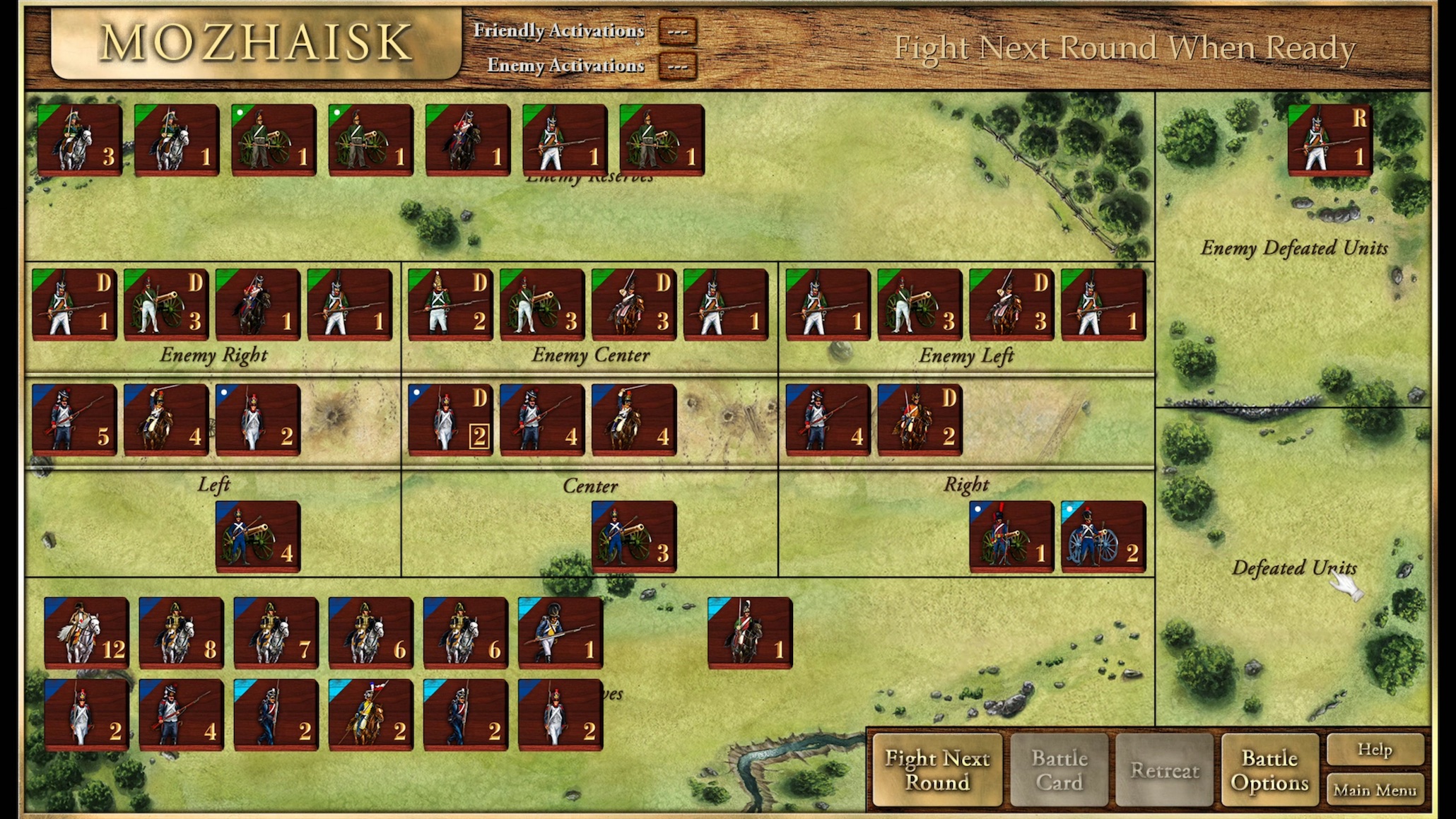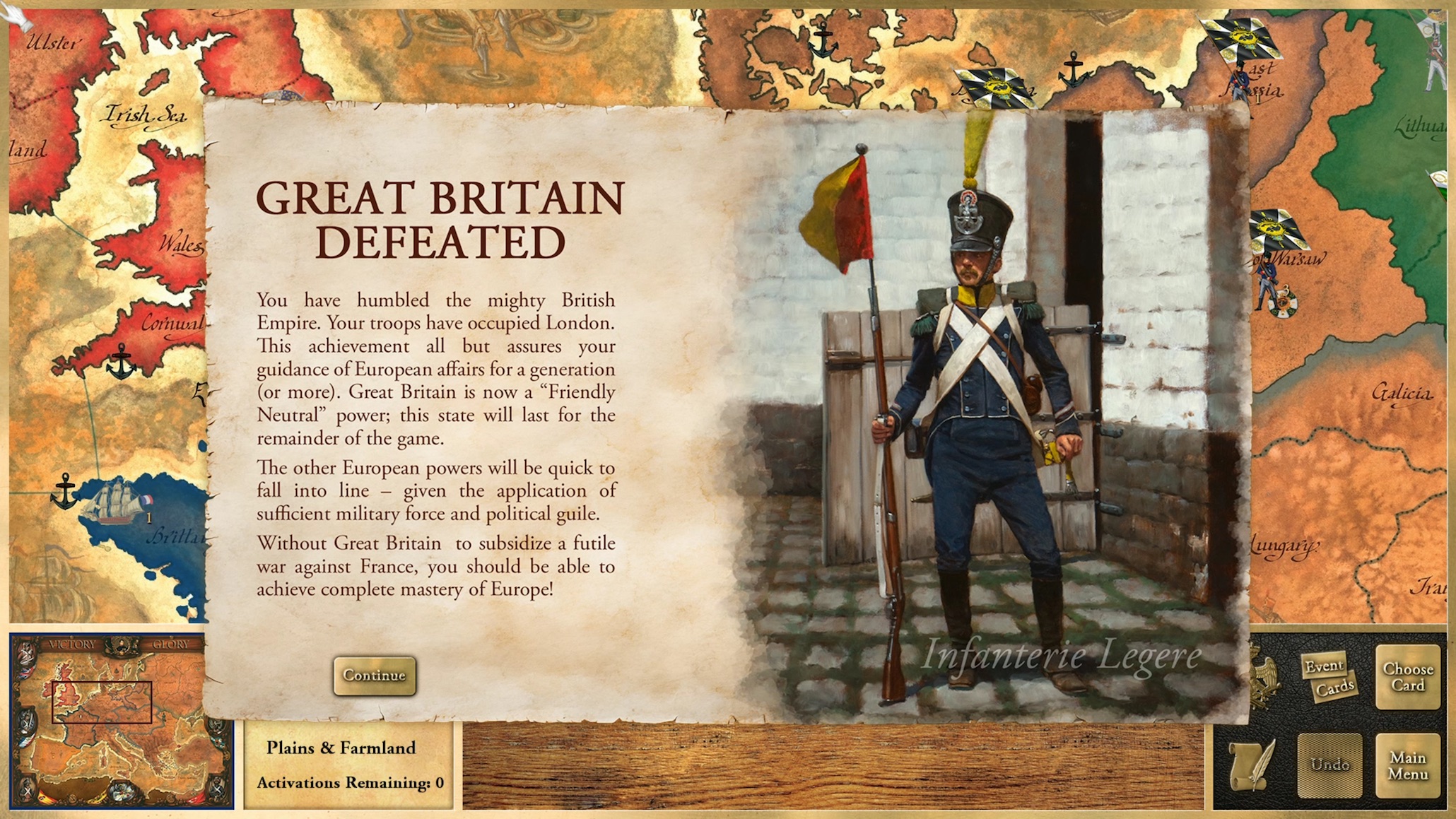Victory and Glory: Napoleon
May 9, 2016 · peterb · 7 minute readGames
The great countries of Europe were pacified. From my throne in Paris, I sat atop the Empire by the middle of 1807.
Victory and Glory: Napoleon is a Windows game that is the first product of a successful kickstarter, and it’s a little gem of a game. Published by Slitherine/Matrix (and not to be confused with the also-just-released Wars of Napoleon), it’s a great take on the era and one that I found hard to stop thinking about, even after I had stepped away from my computer.
I went into the game knowing nothing of the Kickstarter or even the history of the game. After my very first battle, I said to myself “Hey, wait a minute. This feels like the same game engine as Hannibal: Rome and Carthage” (which Tea Leaves reviewed back in 2010). And indeed, that turns out to be the case. “Uh oh,” I said, remembering how difficult I found that game to be, and I immeditely restarted the game on an easier setting.
I needn’t have worried, though - Victory and Glory: Napoleon is finely-tuned, and less of a punishment than Hannibal. Whereas Hannibal was essentially a tutorial in how you can win every battle and still lose the war because of an untenable strategic position, Victory and Glory gives you the tools you need to win or lose based on your own merit. There are certainly challenges to overcome (that damn British navy!) but tactical success generally yields strategic rewards as well.
On the strategic level, the player is Napoleonic France against the other major powers - Britain, Austria, Prussia, Russia, and Spain. Most of the powers can be at war or neutral at various times during the game, but Britain is a permanent antagonist - they are constantly trying to undermine you, and to convince the other major powers to enter a coalition against you . The only way to remove them from the war is by capturing London, which is painfully difficult. There are also regions that can be added to the empire by playing event cards. In addition, two minor powers, Germany and Italy, may or may not exist depending on the state of the game and what cards you have played. The game ends either after a set number of years, or when all major powers are at peace, or when Napoleon dies.
On the strategic map, you muster and move about stacks of infantry, cavalry, and artillery, led by generals who provide a combat bonus (as you might imagine, Napoleon’s bonus is substantial). When at war with a power, you defeat them by occupying their capital and holding it for one turn. This forces the power to become a friendly neutral for a relatively short period of time, roughly a year. Special event cards are available which can make that status permanent. This is one way that the event cards shape your strategy - if you have a card that lets you permanently neuter Prussia, for example, warring on Prussia will be more attractive than warring on Spain
When enemy stacks occupy the same region on the map, you are taken to a battle mode to resolve the fight. If each side has 8 land units or more, it’s considered a “major battle” which is worth victory points - with fewer units, it’s a “minor battle”. Minor battles have one battle line (plus reserves). In major battles, the line is divided into left, center, and right sections, and routing or eliminating all units in any one section wins the battle. Major battles also can involve terrain and special tactics.
As in Hannibal combat is somewhat opaque, but the three-line system introduces a bit more flexibility. The game rewards using tactics appropriate to the era. For example, units receive a defensive bonus for being next to other friendly units, and get a higher bonus for being next to a unit of a different type. Cavalry charges are effective against artillery, but if they encounter an infantry square may be cut to ribbons. Skirmishers can disrupt an enemy before making contact, and the weakest part of an enemy line is generally its flank. So whereas Hannibal felt mostly like a numbers game where the outcome was basically predictable, in Victory and Glory good tactics can turn an expected defeat into a surprising turnaround.
Naval battles are always considered minor, and as the French player you’ll have an uphill fight against the British. On the one hand, this is as it should be - there’s a reason we all know the phrase “Britannia rules the waves”. But the AI does make mistakes the real British didn’t, so in my game I basically just kept my ships in port until the computer player detached a too-small flotilla, pounced on it, and then went back to port. This was a pretty gamey tactic, and is one of the few flaws I found in the game. Repeating this a few times eventually led to Napoleon having tea and crumpets in Buckingham Palace.
Play is advanced also through spending political points to influence the other powers, and by playing Event Cards in both the strategic and battle modes. The cards range from simple activities such as recruiting or upgrading a few troops, to causing a minor province of your choice to join the French Empire, to creating new minor powers such as Italy and Germany. On the battle map, the cards have a similarly wide array of effects, and deciding when to spend these and when to save them is a key part of success in the game. In fact, this is one of the ways that the game lets you adjust difficulty - on lower difficulties, you get more cards, more frequently, and on higher difficulties you get fewer.
The strategic, tactical, and card-based aspects of the game all combine into a convincing whole. If I hadn’t played Hannibal I would have thought that the engine was made specifically for this game. It feels right.
The presentation of the game is lovely, with era-appropriate art on the board and event cards, and classical music (mostly Beethoven - I recognized the Eroica and also the 7th Symphony) setting the mood.
The one (very minor) flaw in the game that I’d call out is how it deals with retreat, and unwinnable battles. On contact with the enemy, the defender is given a chance to retreat, and this attempt to retreat can fail. If your retreat fails, you then go to the battle map, and then fight a minimum of 2 rounds before you can retreat from battle again; this second retreat is always successful, and will trigger attrition from pursuit. Conceptually I like the idea that sometimes you can’t successfully retreat. This can lead to close engagements that you might win or lose. But, most of the times that I tried to retreat I faced overwhelming odds. When a battle is truly hopeless, it is poor design to force the player to slog through several minutes of the battle map to reach the inevitable result. The game does have “overrun” triggers for large enough disparities, but a better design (in my opinion) would be to always allow the defender to aretreat, but make the failure state “suffer casualties” rather than “forced to fight the battle”. It would reach the same result while not making the player spend brain power on a pointless battle.
Victory and Glory: Napoleon is available on Steam for $29.99, or on the web sites for Slitherine and Matrix Games. If you like counter-based wargames, I unreservedly recommend it.
Disclosure statement: Slitherine graciously provided Tea Leaves with a review copy of this game.


